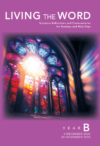Scripture Study for
Twenty-Eight Sunday in Ordinary Time
2 Kings 5:14–17 / Psalm 98:2b / 2 Timothy 2:8–13 / Luke 17:11–19
<< Back to LECTIONARY RESOURCES
Understanding the Word
By Br. John R. Barker, OFM
Naaman is an army commander in Aram, a land just to the north of the northern kingdom of Israel, and its enemy. Naaman also has leprosy. When an Israelite girl, captured in war and now serving Naaman’s wife, tells her about Elisha the prophet, Naaman goes to see him. Expecting some dramatic healing ritual, he becomes angry when he is told simply to wash in the small and unimpressive Jordan (5:1–12). But when his servants prevail upon him to give it a try, he is miraculously cured. The healing of a foreigner demonstrates the scope of the power and mercy of the God of Israel, such that Naaman resolves to worship him when he returns home. The two carts of soil from the land of Israel will form a tiny, holy space in which Naaman will be able to offer sacrifice to Israel’s God.
Paul continues to encourage Timothy to stay firm in his teaching of the true Christian doctrine. He reminds him of the core—and probably most controversial—claim of that doctrine, which is the resurrection of Christ. This proclamation has brought suffering to Paul, just as it may to Timothy. Nevertheless, the suffering must be borne so that all those who have been “chosen” by God may hear the word of God and be saved. (“Chosen” is Paul’s frequent term for those who have accepted the gospel [Romans 8:33, Ephesians 1:11, Colossians 3:12, 1 Thessalonians 1:4]). To fail to teach the truth is to interfere with God’s saving will for others. Paul concludes with another “trustworthy” teaching, namely that those who persevere will be saved and live in glory with Christ. Those who publicly deny Christ by apostatizing, however, will be denied in turn. It is not clear what the distinction is between denying Christ and being unfaithful, but the final point is key. Christ is always faithful because this is his inherent nature.
Because of the fear of spreading leprosy and of ritual uncleanness, those infected were not permitted to mingle with others (Numbers 5:2–3), so the ten lepers run to Jesus before he can enter the village, which is presumably on the border between Galilee and Samaria. In response to their request, he has them fulfill the legal demand that they be certified by the priests as “clean” so that they can be reintegrated into society (Leviticus 14:1–32, Luke 5:12–14). All show some form of faith in Jesus’ words by leaving for the priests before they see evidence of having been healed. Yet only the one who returns to give thanks is told that his faith has saved him. This suggests that healing (physical or spiritual) is only one aspect of salvation; saving faith also means responding to God’s graciousness.
